Review of the Kingmax Hercules Nano RAM Kit - Ancient Greek Hero in Nano-armor
The memory market is saturated with all sorts of solutions for various platforms. Now the user has a truly huge selection of different options - high memory frequency with low latency, high frequency with high latency, low frequency with low latency and low frequency with high latency. In fact, the question of choice comes down to determining the specific case and size of the user's budget. Therefore, manufacturers do not rarely resort to various ways of attracting attention to their products in the form of massive or colorful radiators, lighting modules or equipping them with cooling systems with fans.
The company Kingmax this fall introduced an updated series of RAM Hercules DDR3 type, which do not need additional radiators and can operate at a frequency of 2200 MHz. In the production of models used technology Nano Thermal Dissipation . Instead of radiators that remove heat from memory chips, the module is covered with a special coating of silicon and graphite. This coating contributes to a 10% improvement in heat dissipation compared to conventional DDR3 memory modules.
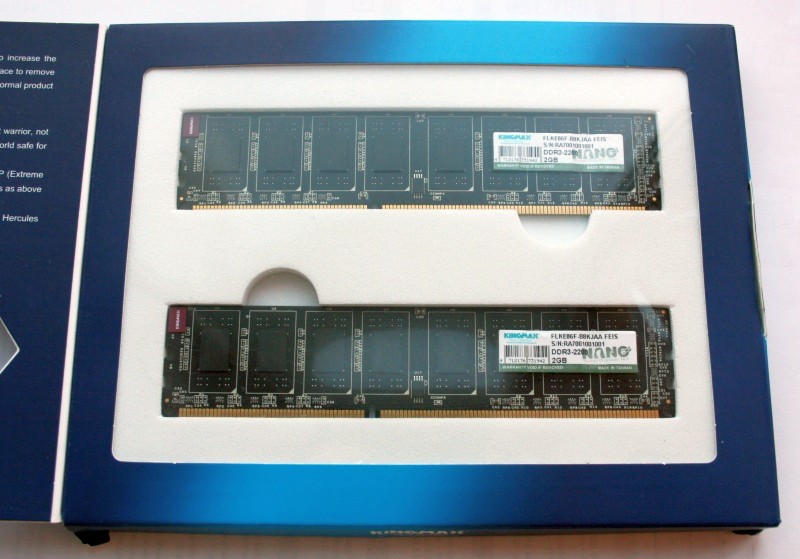
Memory modules are shipped in a small box, made in blue-blue color.
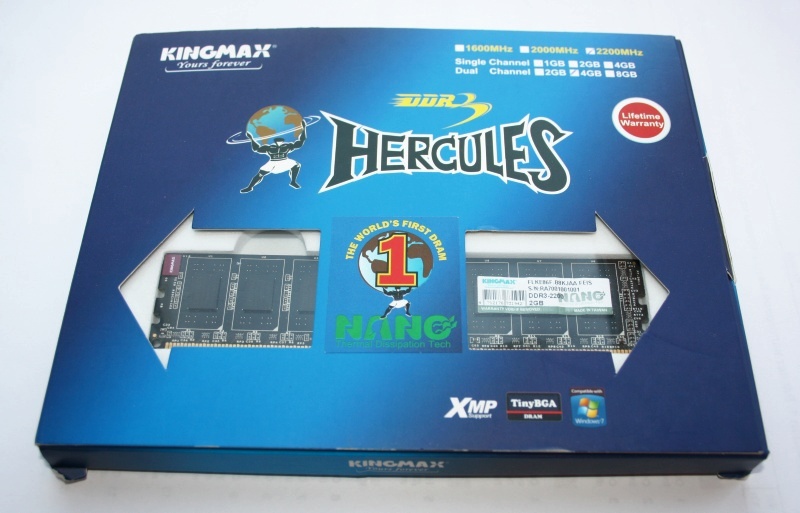
On the front side of which there is a transparent window through which one of the two modules is visible. The first thing that catches your eye is information about the applied Nano Thermal Dissipation technology and a lifetime warranty. Having opened the box, both modules, securely packed in dense porous material, preventing our damage during transportation, appear to our eyes.

On the back of the box are the main characteristics of the memory modules. In the table below they are briefly listed.
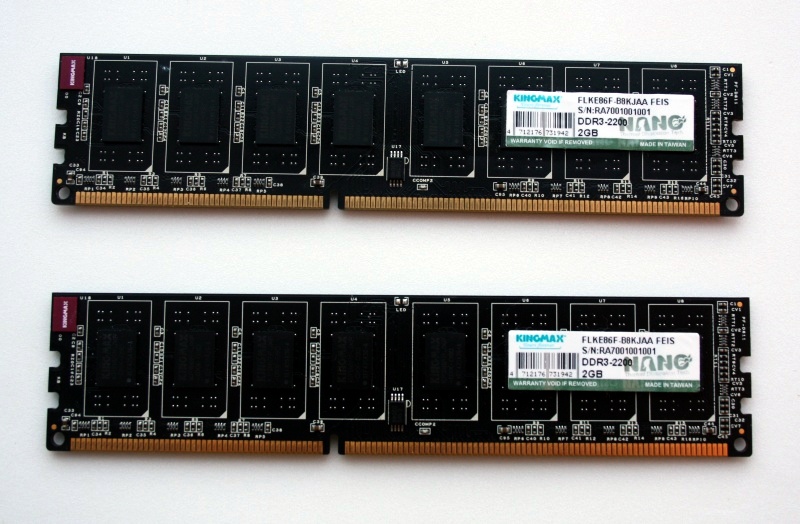
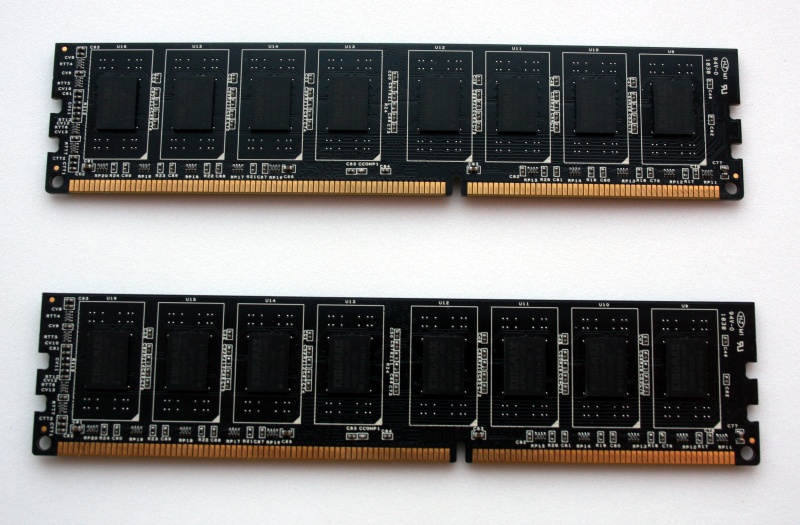
RAM modules are based on black textolite. Each memory module contains 16 memory chips - 8 pieces on each side. The capacity of each module is 2048 MB. The total capacity of the set corresponds to the capacity of both modules, i.e. 4096 MB.
The label located on each module also informs us about the model, serial number, memory type, frequency and volume of the module.
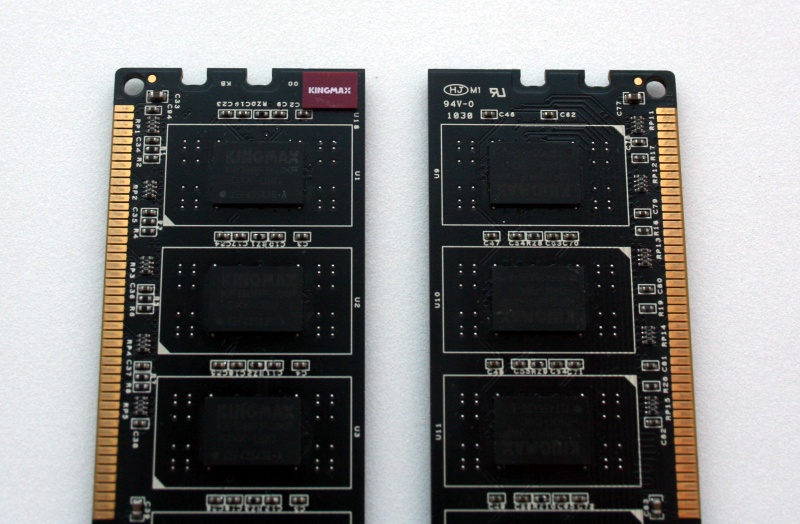
By production of modules the six-layer printed circuit board of HJ M1 with the applied Kingmax sticker was used.
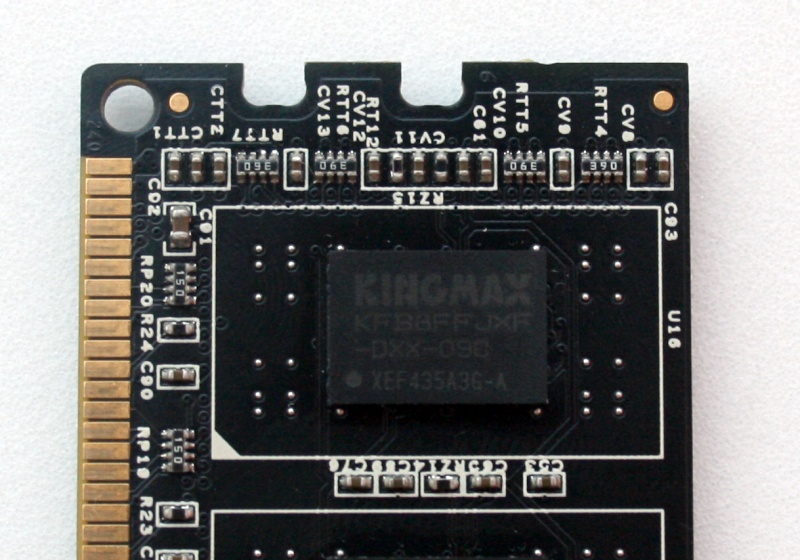
Memory chips are marked as Kingmax KFB8FFJXF-DXX-09C. In fact, memory chips are manufactured by Powerchip, and in this case we are talking about remarking.
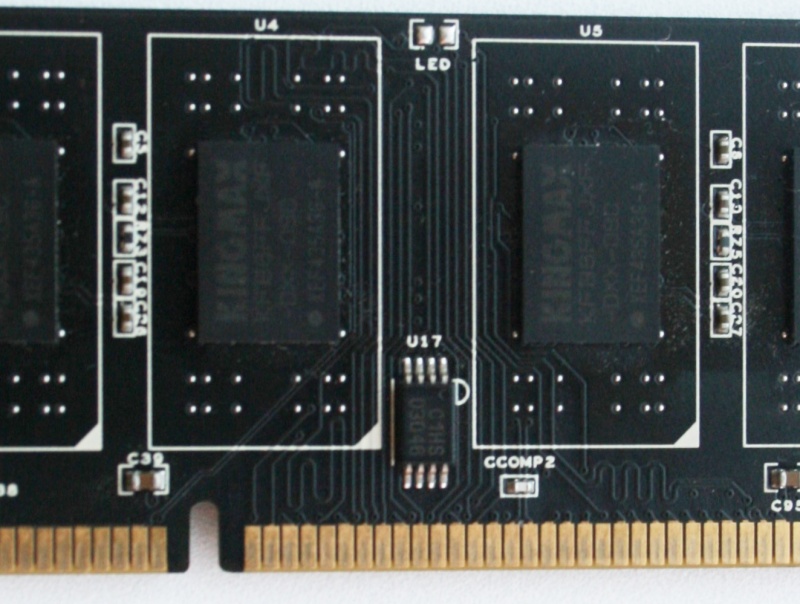
On the PCB textolite space is allocated for the LED, which for some reason is not unsoldered.
The memory modules installed in the ASUS Maximus III Formula motherboard are as follows.

When loaded with Auto Kingmax Hercules Nano parameters are defined as regular modules with a frequency of 1333 MHz and delays of 9-9-9-24 1T.

Activating the XMP profile, we obtain a memory frequency of 2200 MHz with delays of 10-10-10-30 1T.

The manufacturer has recorded the following parameters in the SPD.
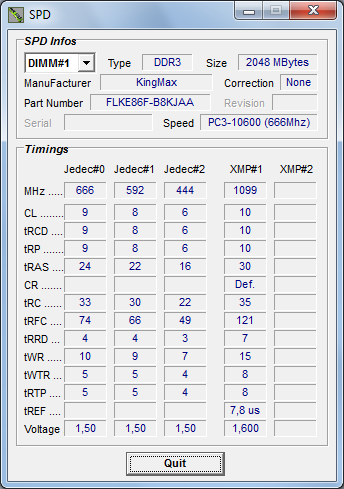
Test configuration and testing methodology
Testing of memory modules for stability was carried out with the memtest86 + version 4.10 utility. The maximum value of the working frequency was determined by successfully passing the test number 5 for at least 10 minutes. The final working memory frequency was achieved using a 2:10 multiplier and overclocking the processor in terms of the frequency of the BCLK. The memory voltage was set manually at 1.65 V.
The memory capacity was tested at factory settings by activating the XMP profile. Also, since the overclocking of the test processor sample was limited in frequency to BCLK to 220 MHz, the memory performance at lower even timings was tested. Additionally, taking into account the peculiarities of overclocking memory on PSC chips, the work on specific timings was checked, namely tRCD = tCL + 3.
')
Test results
Initially, the stability of a set of memory was checked at the settings recorded by the manufacturer in the XPM profile. Successful completion of the test was an unnecessary confirmation of the correct settings.

Studying the overclocking potential with the “even” timings of the beat, three modes were tested: 7-7-7-21 1T, 8-8-8-24 1T, 9-9-9-27 1T. The test results are presented below in the form of a diagram with the added test result with settings corresponding to XMP.

The memory was successfully able to pass the test at frequencies of 1823 with delays of 8-8-8-24 and 2035 at 9-9-9-27. It is worthy of results for the memory of this level.
Studying the potential with the timings more characteristic of PSC memory chips, it didn’t fully open up. The main limitation was a low memory multiplier. The maximum value of which is only 2:10 on the processor Intel Core i5 750, in contrast to 2:12 of the Intel Core i7 8XX.
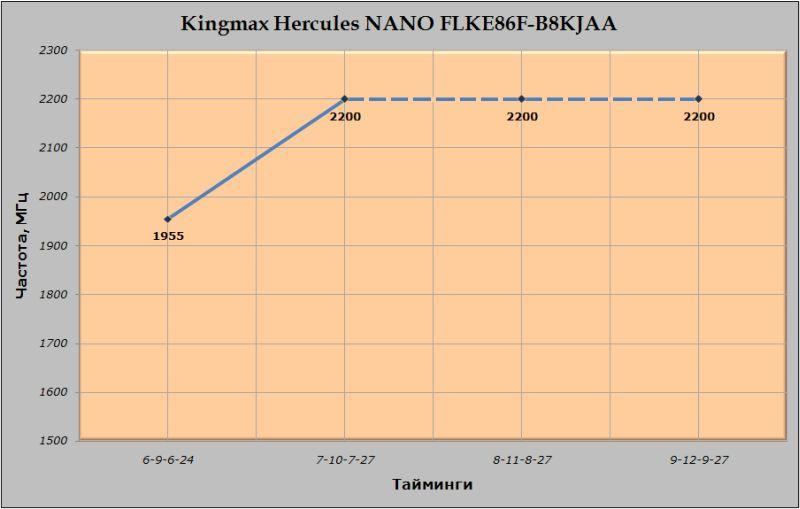
The values for the frequencies with delays of 8-11-8-27 and 9-12-9-27 indicate those that were achieved in these conditions. However, studying the results obtained using this memory and Core i7-8XX processors, you can find results of overcoming the milestone at 2400-2500 MHz with delays of 9-12-9-27 at a supply voltage of 1.65-1.8 V. And this is already a very decent result.
From the above, we can draw the following conclusion: Kingmax managed to prepare a very interesting product attracting attention not only by the lack of radiators and the application of new and unique technologies, but also by a very decent overclocking potential.
According to the test results, the Kingmax Hercules Nano RAM kit receives the Editor's Choice award.

These RAM modules will go on sale with blue color memory chips. The updated modules are as follows:

As you can see, the difference from the tested ones consists only in the color of the memory chips.
The company Kingmax this fall introduced an updated series of RAM Hercules DDR3 type, which do not need additional radiators and can operate at a frequency of 2200 MHz. In the production of models used technology Nano Thermal Dissipation . Instead of radiators that remove heat from memory chips, the module is covered with a special coating of silicon and graphite. This coating contributes to a 10% improvement in heat dissipation compared to conventional DDR3 memory modules.

Memory modules are shipped in a small box, made in blue-blue color.

On the front side of which there is a transparent window through which one of the two modules is visible. The first thing that catches your eye is information about the applied Nano Thermal Dissipation technology and a lifetime warranty. Having opened the box, both modules, securely packed in dense porous material, preventing our damage during transportation, appear to our eyes.

On the back of the box are the main characteristics of the memory modules. In the table below they are briefly listed.
| Title | Kingmax Hercules Nano Thermal Dissipation Technology |
| Marking | FLKE86F-B8KJAA |
| Type of | DDR3 |
| Volume | 2 × 2048 MB |
| Frequency | 2200 MHz |
| Timings | 10–10–10–30 |
| Voltage | 1.5–1.8 V |


RAM modules are based on black textolite. Each memory module contains 16 memory chips - 8 pieces on each side. The capacity of each module is 2048 MB. The total capacity of the set corresponds to the capacity of both modules, i.e. 4096 MB.
The label located on each module also informs us about the model, serial number, memory type, frequency and volume of the module.

By production of modules the six-layer printed circuit board of HJ M1 with the applied Kingmax sticker was used.

Memory chips are marked as Kingmax KFB8FFJXF-DXX-09C. In fact, memory chips are manufactured by Powerchip, and in this case we are talking about remarking.

On the PCB textolite space is allocated for the LED, which for some reason is not unsoldered.
The memory modules installed in the ASUS Maximus III Formula motherboard are as follows.

When loaded with Auto Kingmax Hercules Nano parameters are defined as regular modules with a frequency of 1333 MHz and delays of 9-9-9-24 1T.

Activating the XMP profile, we obtain a memory frequency of 2200 MHz with delays of 10-10-10-30 1T.

The manufacturer has recorded the following parameters in the SPD.

Test configuration and testing methodology
| CPU | Intel Core i5 750 ES (2.67 GHz, Lynnfield, rev. B1) |
| Motherboard | Asus Maximus III Formula (Intel P55, Intel LGA 1156, BIOS 2001) |
| RAM | Kingmax Hercules NANO FLKE86F-B8KJAA |
| Video card | Gigabyte GeForce 9600GT |
| Power Supply | Enermax EMG500AWT (Modu87 +, 500 W) |
| Storage device | SSD Intel X25-V |
| Cooling system | Coolink Corator DS |
Testing of memory modules for stability was carried out with the memtest86 + version 4.10 utility. The maximum value of the working frequency was determined by successfully passing the test number 5 for at least 10 minutes. The final working memory frequency was achieved using a 2:10 multiplier and overclocking the processor in terms of the frequency of the BCLK. The memory voltage was set manually at 1.65 V.
The memory capacity was tested at factory settings by activating the XMP profile. Also, since the overclocking of the test processor sample was limited in frequency to BCLK to 220 MHz, the memory performance at lower even timings was tested. Additionally, taking into account the peculiarities of overclocking memory on PSC chips, the work on specific timings was checked, namely tRCD = tCL + 3.
')
Test results
Initially, the stability of a set of memory was checked at the settings recorded by the manufacturer in the XPM profile. Successful completion of the test was an unnecessary confirmation of the correct settings.

Studying the overclocking potential with the “even” timings of the beat, three modes were tested: 7-7-7-21 1T, 8-8-8-24 1T, 9-9-9-27 1T. The test results are presented below in the form of a diagram with the added test result with settings corresponding to XMP.

The memory was successfully able to pass the test at frequencies of 1823 with delays of 8-8-8-24 and 2035 at 9-9-9-27. It is worthy of results for the memory of this level.
Studying the potential with the timings more characteristic of PSC memory chips, it didn’t fully open up. The main limitation was a low memory multiplier. The maximum value of which is only 2:10 on the processor Intel Core i5 750, in contrast to 2:12 of the Intel Core i7 8XX.

The values for the frequencies with delays of 8-11-8-27 and 9-12-9-27 indicate those that were achieved in these conditions. However, studying the results obtained using this memory and Core i7-8XX processors, you can find results of overcoming the milestone at 2400-2500 MHz with delays of 9-12-9-27 at a supply voltage of 1.65-1.8 V. And this is already a very decent result.
From the above, we can draw the following conclusion: Kingmax managed to prepare a very interesting product attracting attention not only by the lack of radiators and the application of new and unique technologies, but also by a very decent overclocking potential.
According to the test results, the Kingmax Hercules Nano RAM kit receives the Editor's Choice award.

These RAM modules will go on sale with blue color memory chips. The updated modules are as follows:

As you can see, the difference from the tested ones consists only in the color of the memory chips.
Source: https://habr.com/ru/post/110553/
All Articles